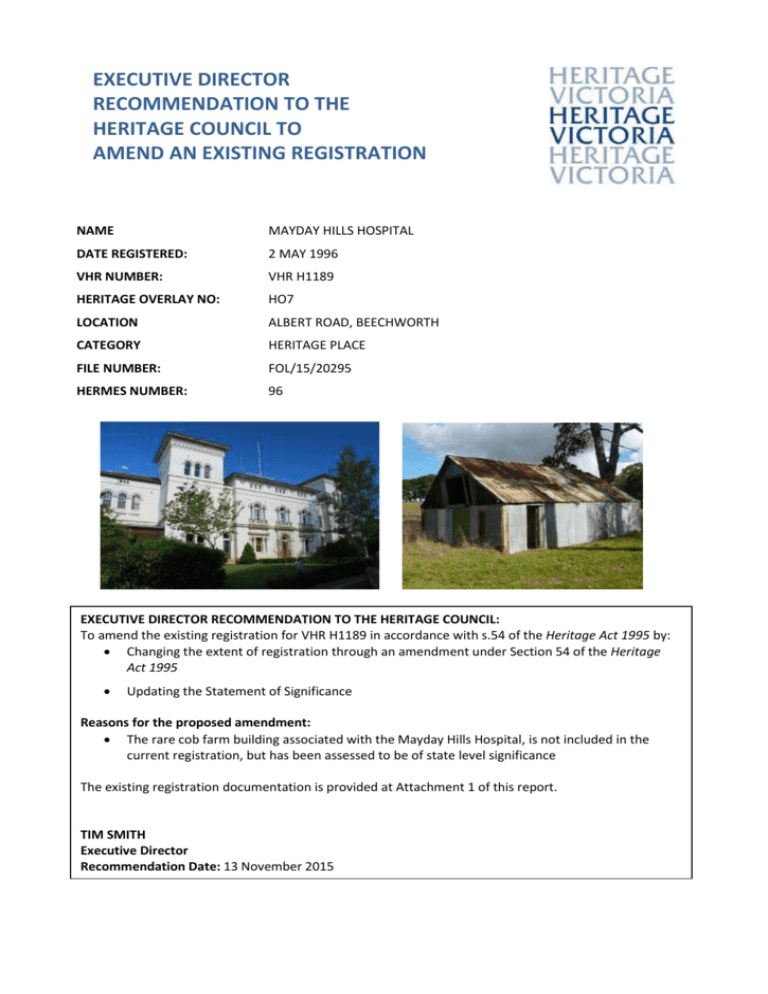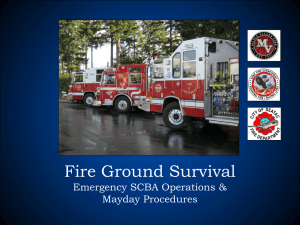amendment reason - Department of Transport, Planning and Local
advertisement

EXECUTIVE DIRECTOR RECOMMENDATION TO THE HERITAGE COUNCIL TO AMEND AN EXISTING REGISTRATION NAME MAYDAY HILLS HOSPITAL DATE REGISTERED: 2 MAY 1996 VHR NUMBER: VHR H1189 HERITAGE OVERLAY NO: HO7 LOCATION ALBERT ROAD, BEECHWORTH CATEGORY HERITAGE PLACE FILE NUMBER: FOL/15/20295 HERMES NUMBER: 96 EXECUTIVE DIRECTOR RECOMMENDATION TO THE HERITAGE COUNCIL: To amend the existing registration for VHR H1189 in accordance with s.54 of the Heritage Act 1995 by: Changing the extent of registration through an amendment under Section 54 of the Heritage Act 1995 Updating the Statement of Significance Reasons for the proposed amendment: The rare cob farm building associated with the Mayday Hills Hospital, is not included in the current registration, but has been assessed to be of state level significance The existing registration documentation is provided at Attachment 1 of this report. TIM SMITH Executive Director Recommendation Date: 13 November 2015 AMENDMENT REASON Change in extent of registration It is proposed that the extent of registration is amended to include the cob farm building, and associated land, that is not currently included in the registration. This building was associated with the farm operations of Mayday Hills Hospital and is located on adjacent land to the south east. It is proposed that the curtilage of the registration be extended to appropriately capture the cultural significance of the whole place. Change to Statement of Significance It is proposed to amend the Statement of Significance for the place to reflect the change in extent and to conform with current formatting. Note: The cob farm building is already included in the Heritage Overlay of the Indigo Shire Planning scheme (HO818) with external paint controls, internal controls and tree controls. PROPOSED CATEGORY OF REGISTRATION No change PROPOSED EXTENT OF REGISTRATION All of the place shown hatched on Diagram 1189 encompassing all of Lots 1, R1 and Res 1 and part of Lot 2 on Plan of Subdivision 722238. The extent of registration of Mayday Hills Hospital in the Victorian Heritage Register affects the whole place shown on Diagram 1189 including the land, all buildings (including the interiors and exteriors), roads, trees, landscape elements and other features. 2 Name: Mayday Hills Hospital VHR number: VHR H1189 Hermes number: 96 AERIAL PHOTO OF THE PLACE SHOWING CURRENT AND PROPOSED REGISTRATION 3 Name: Mayday Hills Hospital VHR number: VHR H1189 Hermes number: 96 PROPOSED STATEMENT OF CULTURAL HERITAGE SIGNIFICANCE What is significant? Mayday Hills Hospital, consisting of a variety of buildings constructed since the establishment of the institution in 1864. The majority of these buildings are contained within a landscape setting which includes part of original brick walls and associated ha-ha. A small group of farm buildings, including a cob building, are located to the south-east of the site. History Summary The Mayday Hills Hospital was constructed as the Beechworth Lunatic Asylum between 1864 and 1867 to designs by the Public Works Department (PWD). Together with asylums at Kew and Ararat, the design of the asylum was based on administrative, planning and medical principles developed in Britain. The original asylum building was contained within a fenced compound, with ha-ha, and the grounds were developed to create an attractive and functional landscape. Active work was considered imperative for patients and workshops were located near the male accommodation and laundries and drying yards near the female accommodation. Farm land located south of the compound also provided patients with productive work. Extensive additions were made to the main building in 1873 and detached cottages with enclosed courtyards were constructed in the late 1880s. In the post-war era the treatment of the mentally ill underwent radical change and many buildings were added to the hospital and earlier buildings were modernised. Mayday Hills Hospital closed in 1995, and the complex was sold to La Trobe University, with various community and commercial organisations occupying parts of the site. The university campus was closed in 2011 and the site sold to a private owner. Description Summary The Mayday Hills Hospital site comprises buildings constructed in a number of periods: the initial construction phase (1864-79); subsequent expansion (1880-90); modernisation, including a nurses’ hostel and ward by PWD architect Percy Everett (1921-50); later development (1951-95) and the period of occupation by La Trobe University (1996-2012). The first phase included a large E-shaped cement rendered building, designed in an Italianate style with corner towers, and a separate morgue constructed to the west in 1868. The main building contained accommodation, administration, laundry, kitchens, stores and a recreation hall. This and later buildings are set within what is now an extensive parkland containing mature exotic and native trees. Parts of the original surrounding wall and ha-ha and one of two entrance lodges remain on the site. Farm land associated with the asylum contains stables (1873), a barn and a small building of earth construction. This site is part of the traditional land of the Kulin Nation. How is it significant? Mayday Hills Hospital is of historical, architectural, technical and aesthetic significance to the State of Victoria. It satisfies the following criteria for inclusion in the Victorian Heritage Register: Criterion A Importance to the course, or pattern, of Victoria’s cultural history. Criterion B 4 Name: Mayday Hills Hospital VHR number: VHR H1189 Hermes number: 96 Possession of uncommon, rare or endangered aspects of Victoria’s cultural history. Criterion D Importance in demonstrating the principal characteristics of a class of cultural places and objects. Criterion E Importance in exhibiting particular aesthetic characteristics. Criterion F Importance in demonstrating a high degree of creative or technical achievement at a particular period. Why is it significant? Mayday Hills Hospital is significant at the State level for the following reasons: Mayday Hills Hospital is historically significant for its physical manifestation of the changing approaches to the treatment of mental illness in Victoria from institutional confinement to treatment and rehabilitation. The asylum at Beechworth was a key component in a larger system of nineteenth century state asylums in Victoria which included those at Kew and Ararat. [Criterion A] The cob farm building at Mayday Hills Hospital is a rare surviving example of cob construction in Victoria. It is one of few known surviving examples in Victoria. [Criterion B] Mayday Hills Hospital is architecturally significant as a particularly fine example of an extensive complex of Italianate asylum buildings dating from the 1860s, and in the case of the cottages, the 1880s. The design is based on an influential asylum at Colney Hatch in England and, in common with other contemporary institutions notably Willsmere in Kew and Aradale at Ararat, displays key characteristic features such as the E shaped plan of the main administration, kitchen and dormitory block with its airing courts and covered walkways, as well as the gatehouse, mortuary and ha-ha wall. The design of the 1860s buildings has been attributed to Public Works Department architect, J J Clark. [Criterion D] The cob farm building at Mayday Hills Hospital is technically significant for the unusual use of cob construction for a small farm building on the site. Double roof construction was used with the inner walls constructed of earth. The technique uses puddled clay, mixed with straw and water, which is laid in courses in a plastic state, without formwork, and pared down once dry. [Criterion E] Mayday Hills Hospital is aesthetically important for the beauty of its picturesque setting on a prominent hill among extensive parklands, which comprises native and introduced trees and shrubs. The curved drive with its avenue of large oaks is particularly noteworthy. [Criterion F] 5 Name: Mayday Hills Hospital VHR number: VHR H1189 Hermes number: 96 PROPOSED PERMIT POLICY DRAFT ONLY – NOT YET APPROVED BY THE HERITAGE COUNCIL Preamble The purpose of the Permit Policy is to assist when considering or making decisions regarding works to a registered place. It is recommended that any proposed works be discussed with an officer of Heritage Victoria prior to making a permit application. Discussing proposed works will assist in answering questions the owner may have and aid any decisions regarding works to the place. The extent of registration of Mayday Hills, Beechworth in the Victorian Heritage Register affects the whole place shown on Diagram 1189 including the land, all buildings, roads, trees, landscape elements and other features. Under the Heritage Act 1995 a person must not remove or demolish, damage or despoil, develop or alter or excavate, relocate or disturb the position of any part of a registered place or object without approval. It is acknowledged, however, that alterations and other works may be required to keep places and objects in good repair and adapt them for use into the future. If a person wishes to undertake works or activities in relation to a registered place or registered object, they must apply to the Executive Director, Heritage Victoria for a permit. The purpose of a permit is to enable appropriate change to a place and to effectively manage adverse impacts on the cultural heritage significance of a place as a consequence of change. If an owner is uncertain whether a heritage permit is required, it is recommended that Heritage Victoria be contacted. Permits are required for anything which alters the place or object, unless a permit exemption is granted. Permit exemptions usually cover routine maintenance and upkeep issues faced by owners as well as minor works or works to the elements of the place or object that are not significant. They may include appropriate works that are specified in a conservation management plan. Permit exemptions can be granted at the time of registration (under s.42 of the Heritage Act) or after registration (under s.66 of the Heritage Act). It should be noted that the addition of new buildings to the registered place, as well as alterations to the interior and exterior of existing buildings requires a permit, unless a specific permit exemption is granted. Cultural heritage management plans A Conservation Management Plan for the place was undertaken in 2012. The report, Lovell Chen, ‘Former Mayday Hills Hospital, Albert Road, Beechworth, Conservation Management Plan Review’ should be used to guide the management of the place in a manner which respects its cultural heritage significance. This report does not include the small farm building of cob earth construction and it is recommended that a Conservation Management Plan is developed to manage this place in a manner which respects its cultural heritage significance. 6 Name: Mayday Hills Hospital VHR number: VHR H1189 Hermes number: 96 RELEVANT INFORMATION DIAGRAM SHOWING SIGNIFICANT FEATURES WHICH CONTRIBUTE TO THE CULTURAL HERITAGE SIGNIFICANCE OF THE PLACE LOCAL GOVERNMENT AUTHORITY Indigo HERITAGE LISTING INFORMATION Heritage Overlay: Yes HO818 Cob Dairy (former) Heritage Overlay Controls: External Paint: Yes Internal Alteration: Yes Tree: Yes 7 Name: Mayday Hills Hospital VHR number: VHR H1189 Hermes number: 96 HISTORY CONTEXTUAL HISTORY Beechworth owes its existence to the discovery of gold in 1852. The Beechworth area was first settled by squatters from 1837, but the discovery of gold resulted in a rush of miners to the area, with about 8,000 arriving by November that year. The Ovens was an important river system in north-east Victoria and gave its name to the goldfields in this area. The town developed around the Gold Commissioner's Camp, established in 1852 on the granite hill on the north bank of Spring Creek. The township was first known as Mayday Hills, but when surveyed in 1853, it was named Beechworth. The main overland route between Melbourne and Sydney passed through the town until the 1870s (when the railway was built further to the west), and until then Beechworth was one of the richest towns in Victoria and the financial and administrative centre of the north-east . Until the mid-1850s most buildings in the town were constructed of wood, bark or canvas, but following the election of a town council in 1856 building regulations were introduced. Many of the town's major buildings were erected during the following five years, including the Ovens District Hospital (1856, VHR H358) and the Burke Museum (VHR H345, begun in 1857 by the Young Men's Association as a hall and library), and the first town hall was built in 1859. By the early 1860s a group of important administrative buildings, known as the Beechworth Justice Precinct (VHR H1464), had been completed along the south side of Ford Street, and a large gaol (VHR H1549) was begun to the north of this in 1858. The Beechworth Lunatic Asylum, later the Mayday Hills Hospital (VHR H1864-67) was built in 1864-67, and the landmark post office (VHR H867) was completed in 1870. The Ovens gold rushes peaked in 1857, and during the following two decades the population of Beechworth decreased (though the last mining company in the district only closed in 1956). Despite the decline in the gold industry the town was sustained well into the twentieth century by the presence of the government institutions founded in the 1850s and 1860s: the asylum and the gaol. Tourism has now become a major industry in Beechworth. Tourism began in the 1880s with the town's reputation as a health resort and picturesque beauty spot. The declining prosperity of the town had the advantage that the post-World War II development that led to the destruction of so much of Victoria's nineteenth century fabric during the 1950s-70s was avoided. At this time there was an increasing awareness of the importance of Victoria's early history and heritage. In the 1960s the National Trust was active in classifying Beechworth's early buildings, and efforts began to restore buildings which had fallen into disrepair. The retention of much of the town's historic character has now made it a popular tourist destination. 8 Name: Mayday Hills Hospital VHR number: VHR H1189 Hermes number: 96 PLACE HISTORY The Mayday Hills Hospital was constructed as the Beechworth Lunatic Asylum between 1864 and 1867 on an elevated site with potential for expansion. The original buildings and structures were arranged within a large square compound fenced by a brick wall and ha-ha. Various additions were made to the buildings and the site in the 1870s and 1880s and the extensive parkland of exotic and native trees developed from the asylum’s establishment. In 1878 it was reported that land under cultivation at the asylum included ’16 acres on the farm, 12 acres in the kitchen gardens, and about 31 acres of ornamental ground, consisting of lawns, shrubberies, flower beds, walks and avenues’. Detached cottages were added in the 1880s and a nurses’ home and new ward, designed by Public Works Department architect Percy Everett, were added in 1936. In association with the asylum, a substantial area to the south-east of the main complex, was set aside for farming activities. A range of work was undertaken by the patients at Mayday Hills Hospital, a great deal of which appears to have been on the farm and in the garden. The role of productive work as meaningful employment was considered to be therapeutic in the treatment of the mentally unwell. Many of the buildings erected were built using asylum labour with local materials often being used. The large hay and straw shed for example was erected on farmland using local materials and asylum labour. A variety of buildings were included in this complex, including stables (1873), barn, piggeries (including 1879 building), fowl houses (including 1909 building), silos (including 1906), farm workers’ quarters, hay and straw sheds. By 1893 an extensive list of vegetables and other crops were produced on the farm at the asylum. A small farm building of unknown date is located to the east of the farm complex. It is of earth construction with covering structure of corrugated iron. Although its original use is not clear, it was probably constructed as a cool room, possibly a dairy. If this use is correct, the building may have been constructed c1880, after the construction of more pigsties in 1879. The raising of pigs and dairying were compatible industries as the dairy waste (whey and skim milk) was fed to the pigs. It would appear that the function of the building has been changed over time. If initially constructed for use as a cool room, it may have since been used as a smoke room and /or a chicken pen. Mayday Hills Hospital closed in 1995 and the complex operated as a campus of La Trobe University until 2011. Various community and commercial organisations occupied parts of the site at this time. The university campus was closed in 2011 and the site sold to a private owner. CONSTRUCTION DETAILS Architect name: PWD, original building attributed to J J Clark Architectural style name: Victorian Period Italianate (original building) Builder name: A Linacre (original building) Construction started date: 1864 (original building) Construction ended date: 1867 (original building) VICTORIAN HISTORICAL THEMES 04 Transforming and managing land and natural resources 4.4 Farming 08 Building community life 8.3 Providing health and welfare services 9 Name: Mayday Hills Hospital VHR number: VHR H1189 Hermes number: 96 The following information is provided to support the inclusion of the cob farm building in the registration of the Mayday Hills Hospital PHYSICAL DESCRIPTION The cob farm building comprises a double wall and roof structure. The inner building is rectangular in form with a door, fireplace and vents at floor level. It has a gable roof with rudimentary timber roof frame and timber lining boards. The building is constructed of earth, on a masonry base, and utilises a technique known as cob construction. This consists of clay mixed with straw and water which is laid course by course while in a plastic state. As each course dries another course is laid and the walls are pared down as the work progresses. This type of earth construction contrasts with dry mud brick which is laid in a conventional way (adobe) or rammed earth (pise) which uses formwork. The timber door frames were set into place after the cob walls were dry. There is some evidence of finishing coats, possibly lime-based, to the exterior and interior of the cob farm building. A metal lattice strapwork panel, similar to that found in the frieze on the verandahs at the Mayday Hill wards (1880-1900) and the gable end of the stables (1873), has been placed above the doorway at the east end and this may help to date the building to the 1870s-80s. Together with ground floor vents, this strapwork panel allows ventilation of the building. There is a brick infill section to the upper west wall. The brick fireplace has an arched opening, however a chimney has been removed at some stage. The fireplace appears to have been either reconstructed or was constructed after the original construction as the bricks appear to date from the 1920s. There are low brick walls internally which appear to be a later addition. Surrounding the cob building is a timber framed structure which creates a double skin. This outer structure consists of a timber framed roof supported on 16 timber bush poles. This outer roof, clad in corrugated iron, extends about 120-150 cm wider and longer than the cob structure to protect it from the elements and possibly keep it cool. The roof sits 15 to 20 cm above the inner roof, allowing air movement between the two structures. The roof and walls are clad with galvanised corrugated iron, with gable ends infilled with vertical timber boards. A large part of this structure is the result of work undertaken c1980 when the exterior posts were badly decomposed and the roof had subsequently collapsed onto the inner roof. At this time netting surrounded the entire building with no evidence of outer cladding. There is no evidence of former cladding materials. OBJECTS AND INTERIORS The interior of the cob building contains an arched fireplace on one wall, low brick walls that may have supported a slate shelf, vents at ground level and iron tie rods spanning across the space. The placement of the outer shelter provides a generous passageway between the double walls. 10 Name: Mayday Hills Hospital VHR number: VHR H1189 Hermes number: 96 LANDSCAPES, TREES & GARDENS Four Corsican Pine (Pinus nigra var. Corsicana) trees are located near the cob farm building - three to the north and one to the west. ARCHAEOLOGY N/A INTEGRITY/INTACTNESS The cob farm building remains largely intact despite a number of changes that have occurred since construction. The outer timber framed structure, clad with corrugated iron, was largely reconstructed c1980s however the inner cob building is intact. Some alterations may have been made to the interior. The fireplace appears to have been rebuilt or a later addition and this may indicate a change in use. If the initial structure was a cool room or dairy, it is possible that the building was adapted for use as a smokehouse and finally the chicken wire, removed from the building in the 1980s, may indicate use as a chicken pen. Despite these alterations, little physical deterioration of the cob construction has occurred. The heritage values of this type of structure are readily identifiable. (July 2015) CONDITION The inner cob structure is in fair condition indicating that it has been protected by an outer structure for a long period. Some repairs have been made to the upper sections of the walls with mud brick and a portion of brickwork has been added to the west wall. (July 2015) COMPARISONS FOR COB FARM BUILDING In ‘Australian Building: a Cultural Investigation’ Miles Lewis states that ‘Cob walling is barely recorded in early Victoria’ with the exception of Bear’s Castle which he describes as ‘one of the only known pure cob structures in Victoria and it dates from about 1847’. He also comments that there may have been others in the same area which no longer remain. Lewis states that ‘after Bear’s Castle little is heard of cob in Victoria for two or three decades.’ He then provides references to mud-walled places, one at Nunawading in 1876 and another at Ravenswood in 1879. It is apparent that cob construction was not a commonly used method of construction in Victoria and few known examples survive. A lack of durability of this type of construction would have reduced numbers of surviving cob structures. Bears Castle, Yan Yean VHR H1420 Bear's Castle was constructed in Yan Yean c1846 for John Bear an early pastoralist who had migrated from England with his family in 1841. Bear's Lookout (or Bear's Folly as it is also known), is a small, two storey structure roughly square in plan and occupying an area of less than 12 square metres. It is built of mud/clay a common primitive building material apparently used extensively in the Whittlesea area and utilises a technique known as cob, popular in the builders' home town of Devon. Cob is a walling construction method 11 Name: Mayday Hills Hospital VHR number: VHR H1189 Hermes number: 96 using clay, straw, gravel and sand. The building was constructed to resemble a castle with a pyramid shaped roof and turrets at each corner - one with a stair and another in brick and stone with a chimney. Bear's Castle is architecturally significant as a rare and outstanding example of a cob constructed building, further enhanced by its form and size, and is believed to be the only cob building remaining in Victoria. The building form is believed to be unique in Victoria not only because it is, arguably, Victoria's only example of a castle-keep, but also because of its aesthetic pointed arched openings built around forked tree branches. It is an excellent example of the importation of a building technique (cob construction) from another country through the direct migration of skills and the adaptation of that technique to the local environment. Bear’s Castle, Yan Yean The farm building at Mayday Hills Hospital is far smaller and of less sophisticated design than Bear’s Castle. However the apparent rarity of this type of construction, and the absence of known remaining examples of this type of construction in Victoria, makes the example at Mayday Hills highly significant. KEY REFERENCES USED TO PREPARE ASSESSMENT D Kemp. ‘Report on the Cob Dairy at Mayday Hills Beechworth’, 2015 Lovell Chen. ‘Former Mayday Hills Hospital Conservation Management Plan Review’, 2012 Miles Lewis, ‘Australian Building: a Cultural Investigation’ at http://www.mileslewis.net/researchdatabase.html Emails from Colin Gladstone, providing details of reconstruction work in c1980s, dated 2 August 2015 & 12 August 2015 12 Name: Mayday Hills Hospital VHR number: VHR H1189 Hermes number: 96 ADDITIONAL IMAGES Cob farm building from north Passage between south side of cob farm building and surrounding corrugated iron outer structure 13 Name: Mayday Hills Hospital VHR number: VHR H1189 Hermes number: 96 South passage East entry to cob farm building Roof over inner structure 14 Name: Mayday Hills Hospital VHR number: VHR H1189 Hermes number: 96 Interior views of cob farm building 15 Name: Mayday Hills Hospital VHR number: VHR H1189 Hermes number: 96 Detail of cob construction on masonry base 16 Name: Mayday Hills Hospital VHR number: VHR H1189 Hermes number: 96 ATTACHMENT 1 EXISTING REGISTRATION DETAILS TO BE SUPERSEDED BY THE FOREGOING RECOMMENDATION EXISTING EXTENT OF REGISTRATION AMENDMENT OF REGISTER OF HISTORIC BUILDINGS Historic Building No. 1189: Mayday Hills Hospital, Albert Road, Beechworth, Shire of Indigo. Extent: To the extent of: 1. All of the buildings known as Mayday Hills Hospital marked B-1 to B-21 on Plan 603184 endorsed by the Chair, Historic Buildings Council and held by the Director, Historic Buildings Council. 2. All of the land as marked L-1 and L-2 on Plan 603184 endorsed by the Chair, Historic Buildings Council and held by the Director, Historic Buildings Council, being part of Crown Allotment 11D, Section C2 in the Parish and Township of Beechworth, County of Bogong. [Victoria Government Gazette No. G17 2 May 1996 pp.1083-1084] 17 Name: Mayday Hills Hospital VHR number: VHR H1189 Hermes number: 96 EXISTING STATEMENT OF CULTURAL HERITAGE SIGNIFICANCE What is significant? The Mayday Hills Hospital was initially constructed as the Beechworth Lunatic Asylum between 1864 and 1867 by contractor Abraham Linacre probably to the design of Public Works Department architect JJ Clark. The buildings from this early period are cement rendered, one and two storeyed Italianate structures set within what is now an extensive parkland containing mature exotic and native trees and remnants of the original encircling ha-ha wall. The main asylum building features typical covered walkways and airing courts. The detached cottages which were constructed in the 1880s have enclosed courtyards. The nurses' quarters and the ward now known as Turquoise were built to the design of Public Works Department architect Percy Everett in 1936. In the post-war era the treatment of the mentally ill underwent radical change and many 18 Name: Mayday Hills Hospital VHR number: VHR H1189 Hermes number: 96 buildings were added to the hospital and earlier buildings modernised. Despite this, the hospital displays a high degree of physical integrity and is in generally good condition. How is it significant? Mayday Hills Hospital is architecturally, historically, socially and aesthetically important to the State of Victoria. Why is it significant? Mayday Hills Hospital is architecturally significant as a particularly fine example of an extensive complex of Italianate asylum buildings dating from the 1860s, and in the case of the cottages, the 1880s. The design is based on the influential asylum at Colney Hatch in England and, in common with other contemporary institutions notably Willsmere in Kew and Aradale at Ararat, displays key characteristic features such as the E shaped plan of the main administration, kitchen and dormitory block with its airing courts, covered walkways, as well as the gatehouse, mortuary and ha-ha wall. The restrained design of the 1860s buildings is attributed to the important Public Works Department architect, JJ Clark. Mayday Hills Hospital is historically and socially important for its physical manifestation of the changing approaches to the treatment of mental illness in Victoria from institutional confinement to treatment and rehabilitation, and from barracks, through cottages to wards. Beechworth was a key component in a system of nineteenth century asylums which included those at Kew and Ararat. The Mayday Hills Hospital has been crucially important in the social history of Beechworth and has, along with the gaol, contributed significantly to the economic viability and survival of this historically important town. Its size and prominent siting have had an important and long lived social and economic impact on the town and region. Mayday Hills Hospital is aesthetically important for the beauty of its picturesque setting on a prominent hill among extensive parklands made up of native and introduced trees and shrubs. The curved drive with its avenue of large oaks is particularly noteworthy. . EXISTING PERMIT POLICY No current permit policy. EXISTING PERMIT EXEMPTIONS No current permit exemptions. 19 Name: Mayday Hills Hospital VHR number: VHR H1189 Hermes number: 96



